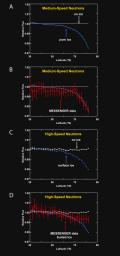
|
Neutron Spectrometer Measurements
- Click the image above for a larger view
- Full-Res JPEG (1980 x 4235) (383.7 kB)
- Full-Res TIFF (1980 x 4235) (25.2 MB)
Caption:
Comparisons of simulated neutron flux and neutron flux measured by MESSENGER's Neutron Spectrometer versus latitude.
(A) Simulated variations of medium-speed (or epithermal) neutrons with latitude are shown under two hypotheses: (1) there is no ice in the radar-bright regions; and (2) all radar-bright regions consist of a thick layer of pure water ice. The vertical axis shows the relative neutron flux (or relative number of neutrons per given time), the horizontal axis shows latitude, and the north pole is at the right at 90° latitude. If the radar-bright regions have little to no water ice, the neutron flux will show no change with latitude (white line). If the radar-bright regions consist of pure water ice, the neutron flux will show a decrease toward the north pole (blue line).
(B) MESSENGER Neutron Spectrometer measurements of the flux of medium-speed neutrons versus latitude are shown in red. The data closely match the simulation with pure water ice within Mercury's radar-bright areas. These data demonstrate that Mercury's polar regions have enhanced hydrogen at concentrations consistent with pure ice in the polar deposits.
(C) High-speed (or fast) neutrons complement the medium-speed neutrons by providing a measure of the burial depth of a thick layer of water ice beneath a thinner surface layer of material with less hydrogen. Simulated variations of high-speed neutrons are shown for two hypotheses: (1) there is no ice in the radar-bright regions; and (2) all radar-bright regions consist of a thick layer of pure water ice at the surface. If the radar-bright regions have little to no water ice, the neutrons will show no change with latitude (white line). If the radar-bright regions consist of pure water ice at the surface, the neutron flux will show a decrease toward the north pole (blue line).
(D) High-speed (or fast) MESSENGER Neutron Spectrometer measurements of the flux of high-speed neutrons versus latitude are shown in red. The decrease in neutron flux toward the north pole is smaller than expected if water ice were at the surface in all radar-bright areas. Therefore, high-speed neutrons indicate that most of the water ice is buried, on average, by a layer of low-hydrogen material 10 to 20 cm thick.
Instrument: Neutron Spectrometer
Background Info:
The MESSENGER spacecraft is the first ever to orbit the planet Mercury, and the spacecraft's seven scientific instruments and radio science investigation are unraveling the history and evolution of the Solar System's innermost planet. Visit the Why Mercury? section of this website to learn more about the key science questions that the MESSENGER mission is addressing. During the one-year primary mission, MDIS acquired 88,746 images and extensive other data sets. MESSENGER is now in a year-long extended mission, during which plans call for the acquisition of more than 80,000 additional images to support MESSENGER's science goals.
For information regarding the use of images, see the MESSENGER image use policy .
Cataloging Keywords:
| Name | Value | Additional Values |
|---|---|---|
| Target | Mercury | |
| System | ||
| Target Type | Planet | |
| Mission | MESSENGER | |
| Instrument Host | MESSENGER | |
| Host Type | Orbiter | |
| Instrument | Gamma Ray and Neutron Spectrometer (GRNS) | |
| Detector | ||
| Extra Keywords | Color, Radar, Radio, Thermal, Water | |
| Acquisition Date | ||
| Release Date | 2012-11-30 | |
| Date in Caption | ||
| Image Credit | NASA/Johns Hopkins University Applied Physics Laboratory/Carnegie Institution of Washington | |
| Source | photojournal.jpl.nasa.gov/catalog/PIA16526 | |
| Identifier | PIA16526 | |
